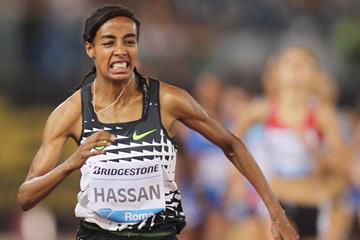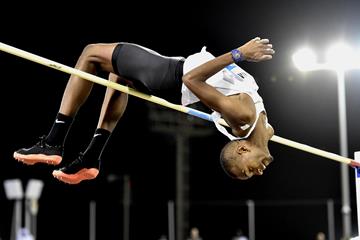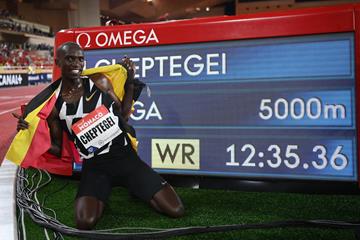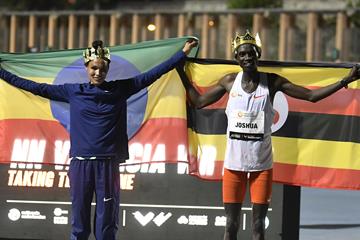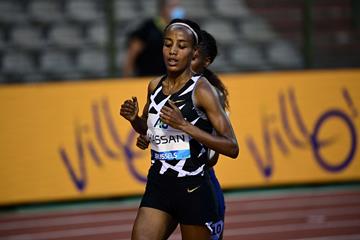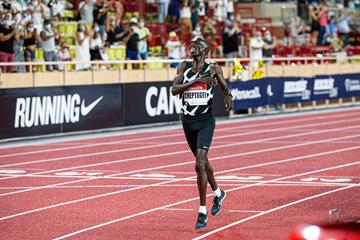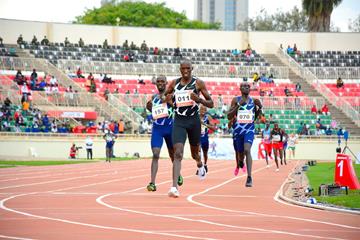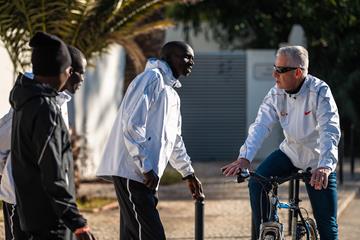 Countdown
Countdown
 Countdown
Countdown
The 5000m is a classic long-distance track and field event that covers 12-and-a-half laps of a standard 400m track. The winner is the athlete who crosses the finish line first.
Men have competed in the 5000m event at the Olympic Games since 1912
The women’s 5000m made its debut at the 1996 Olympics in Atlanta, USA, when the event replaced the women’s 3000m
The 5000m is a common event at many major championships, including the World Athletics Championships
At major championships, there are typically 5000m heats and then a final
Historically, Finland has produced the most men’s 5000m Olympic champions with six. This includes four successive titles from 1924 to 1936
In modern Olympic history, athletes from the east of Africa have dominated the event
As a long-distance running event, breaking a world 5000m record requires skill, strength, endurance and aerobic capacity.
The first recognised women’s world 5000m record was set by British athlete Paula Fudge in September 1981. She completed the race in 15:14.51. However, Fudge only held on to the record for six months. This is because, in March 1982, New Zealand’s Anne Audain beat her time by just over one second when she clocked 15:13.22.
The first woman to run 5000m in less than 15 minutes was Norway’s Ingrid Kristiansen, who ran 14:58.89 in June 1984. Just over a year later, Zola Budd-Pieterse took the record with a time of 14:48.07, but one year later Kristiansen reclaimed the record with 14:37.33.
Since 2006, the world record has only been set by African athletes. The current world record-holder is Ethiopian runner Gudaf Tsegay, who achieved a time of 14:00.21 in September 2023.
The first recognised men’s 5000m world record was set by Finland’s Hannes Kolehmainen, who ran 14:36.6 in July 1912. For the next 30 years, only Finnish athletes broke the record. Then, in September 1942, Sweden’s ran the first sub-14-minute 5000m, clocking 13:58.2.
The first sub-13-minute time was achieved by Moroccan athlete Saïd Aouita, who ran 12:58.39 in July 1987. Aouita held on to the record for seven years, until Haile Gebrselassie achieved his first world record in June 1994. In total, Gebrselassie has held the record four times, with his fastest time being 12:39.36 achieved in June 1998.
The current world record is held by Uganda's Joshua Cheptegei, who ran 12:35.36 in August 2020.

In the men’s 5000m, Finnish athlete Paavo Nurmi won two Olympic silvers and a gold at this distance. Meanwhile, Mo Farah won two Olympic golds and three World Championships golds. Similarly, Norwegian Jakob Ingebrigtsen won two back-to-back World Championships golds.
In the women’s 5000m, Ethiopian athlete Meseret Defar has won two Olympic golds and a silver, Kenyan Hellen Obiri is a back-to-back World Championships gold medallist, and Romanian Gabriela Szabo also won two World Championships golds alongside an Olympic gold.
The 5000m is a challenging long-distance running event as it requires athletes to run consistently for about 14 minutes at the elite level. This takes a huge amount of physical and mental strength.
Here’s how to run 5000m:
The athlete stands at the start line in a standing position, with their hands not touching the ground
All athletes start from a bunched standing start and can break immediately for the inside
A strong, clean start off the line is crucial to get a position at the head of the pack
Athletes should make sure to avoid getting boxed in, as this can impede progress
During the initial laps, athletes establish a steady pace and avoid overexertion, as this can cause them to burn out quickly
During the middle laps, athletes will start to feel fatigued but will rely on mental strength to push past these feelings
The final lap is typically the fastest as the athletes use all their energy to sprint to the finish
Athletes must use their tactical awareness to make sure other athletes don’t pass them as they make their way to the finish line and avoid being passed
As with all long-distance races, there are 5000m race rules that ensure fairness and the safety of all athletes.
The 5000m is an event that takes place on a standard 400m track. Athletes complete 12-and-a-half laps during the race. This event is different from the 5km race, which is a road-running event.
Athletes start the race in a standing position. They don’t touch the ground and don’t use starting blocks.
A false start is called if an athlete starts the race before the starting pistol is fired. An athlete who commits a false start is immediately disqualified. However, this is rare.
A 5000m athlete will be disqualified if:
They commit a false start
They leave the track (moving into lane one is permitted)
They deliberately obstruct another competitor
They do something that could be viewed as unsportsmanlike conduct
The winner of the race is the athlete whose torso crosses the finish line first. Any other body parts that may cross before the torso, such as head, hands and feet, will not count.
There are no legal wind speeds in the 5000m event.
The 5000m is 12-and-a-half laps of a standard 400m track.
Running the 5000m requires a balance of skill, speed and endurance. Here’s how to pace a 5000m race:
Begin the race with an initial burst of speed to establish yourself in a favourable position
Find a steady rhythm and use all of your mental strength to overcome any pain and exhaustion that may begin to set in
During the final laps, if you have enough stored energy, increase your pace to pull away from the pack. In tactical races it can be useful to conserve enough energy for a kick on the final lap
On the last lap, sprint for as long and as hard as your remaining energy allows
Preparation for a 5000m should begin at least two months before a race. Without the proper preparation, you will likely struggle to finish the race in a strong time.
You should aim to train three to four times per week, using a combination of long-distance running, sprints and tempo runs. Varying the types of runs you do will help build your endurance.
Strength training will, of course, build your strength, so spending time at the gym is also necessary. Just as important is getting regular rest, which helps your body to recover and will help lessen the risk of injury.
You must also eat a balanced diet and make sure you stay well hydrated.
The 5000m is also partially about mental strength, so think positively, set yourself some goals and try to visualise yourself finishing the race.
There are no rules that forbid the use of sprint spikes in the 5000m. However, athletes are only likely to hinder their own performance, rather than help it. Sprint spikes are only in the front part of the shoe and don’t support the heel, which means if athletes wear them to run a long-distance race, it’s likely to be uncomfortable and cause an injury.
Long-distance running refers to any running event where athletes run a distance greater than 3000m (1.86 miles). This includes the 5000m, 10,000m, half marathon and the marathon.
Paris 2024 Olympic Games
World Athletics Championships Tokyo 25
World Athletics U20 Championships Lima 24
 FRA
FRA
 ETH
ETH
 USA
USA
 ETH
ETH
 USA
USA
 ETH
ETH
 BRN
BRN
 USA
USA
 AUS
AUS
 BEL
BEL
 KEN
KEN
 ITA
ITA
 ETH
ETH
 KEN
KEN
 KEN
KEN
 ETH
ETH
 ETH
ETH
 ETH
ETH
 USA
USA
 USA
USA
